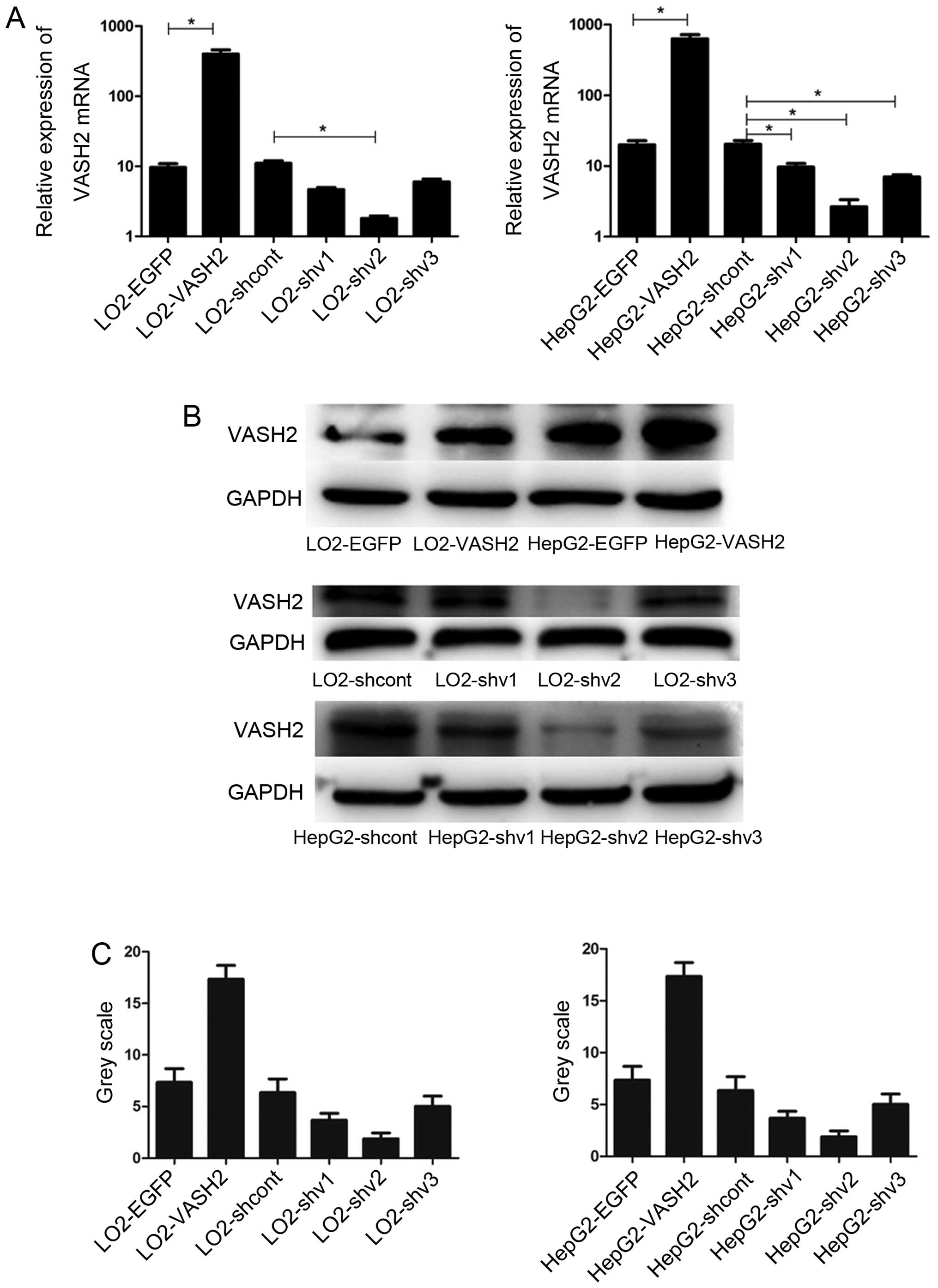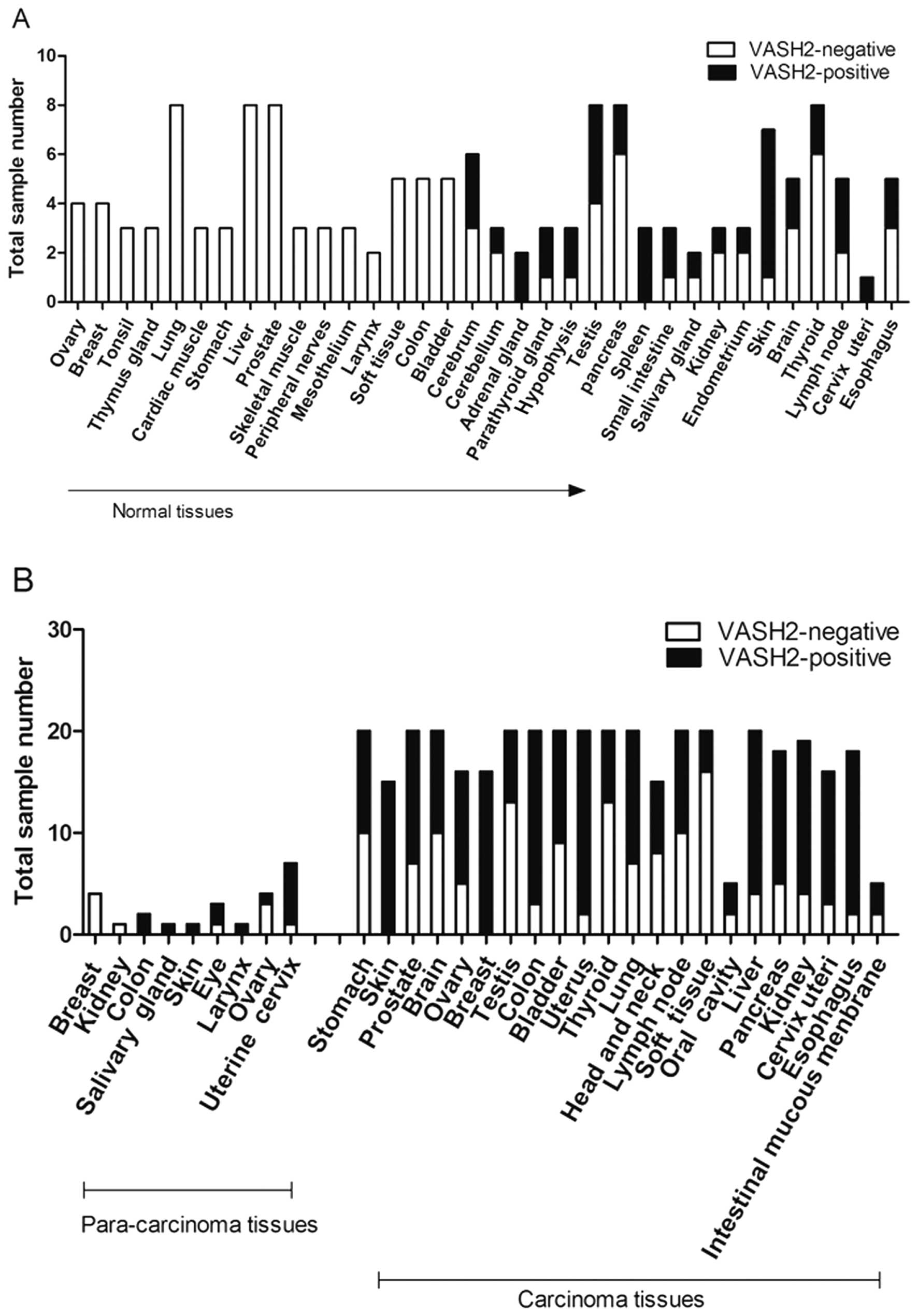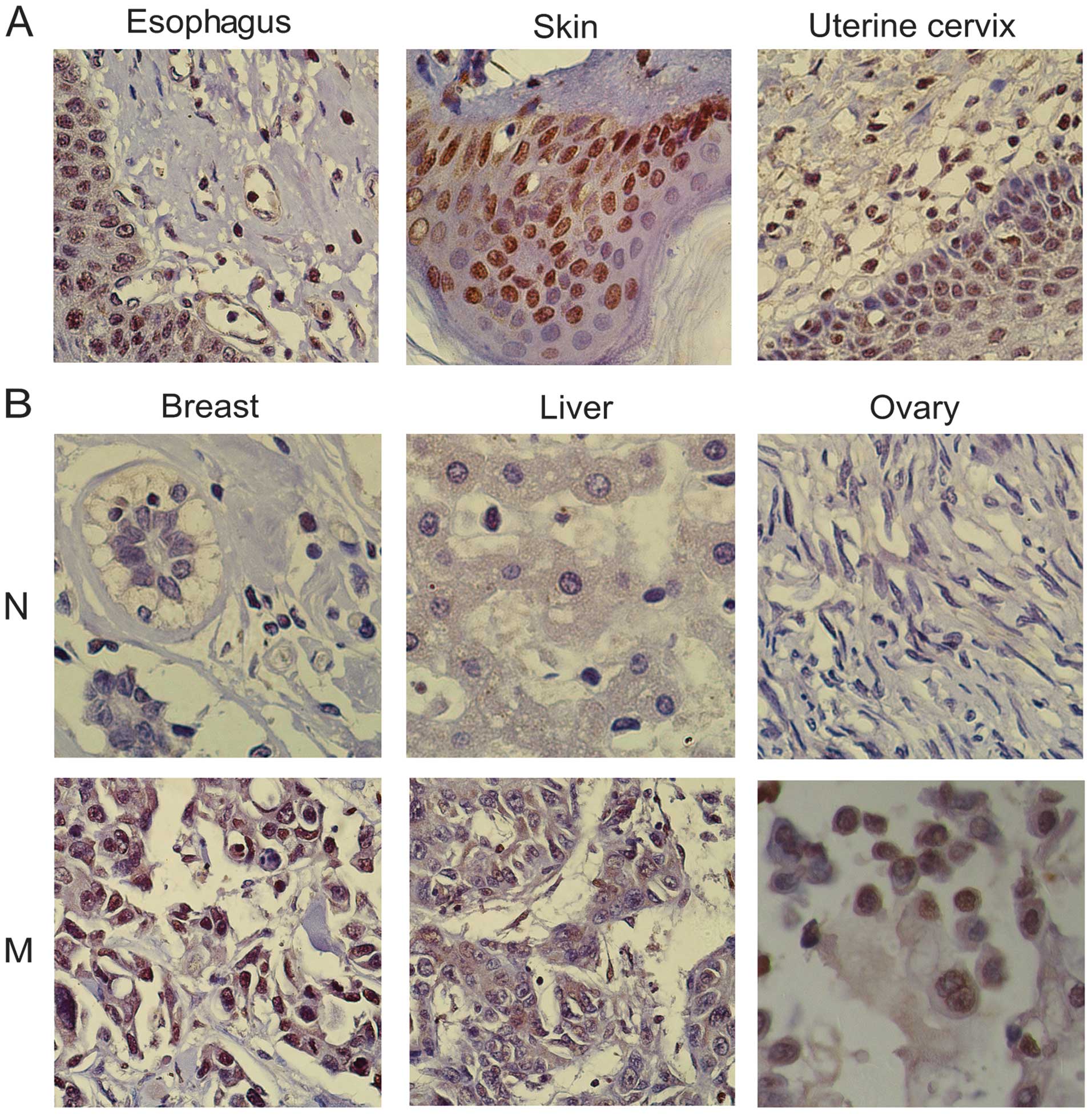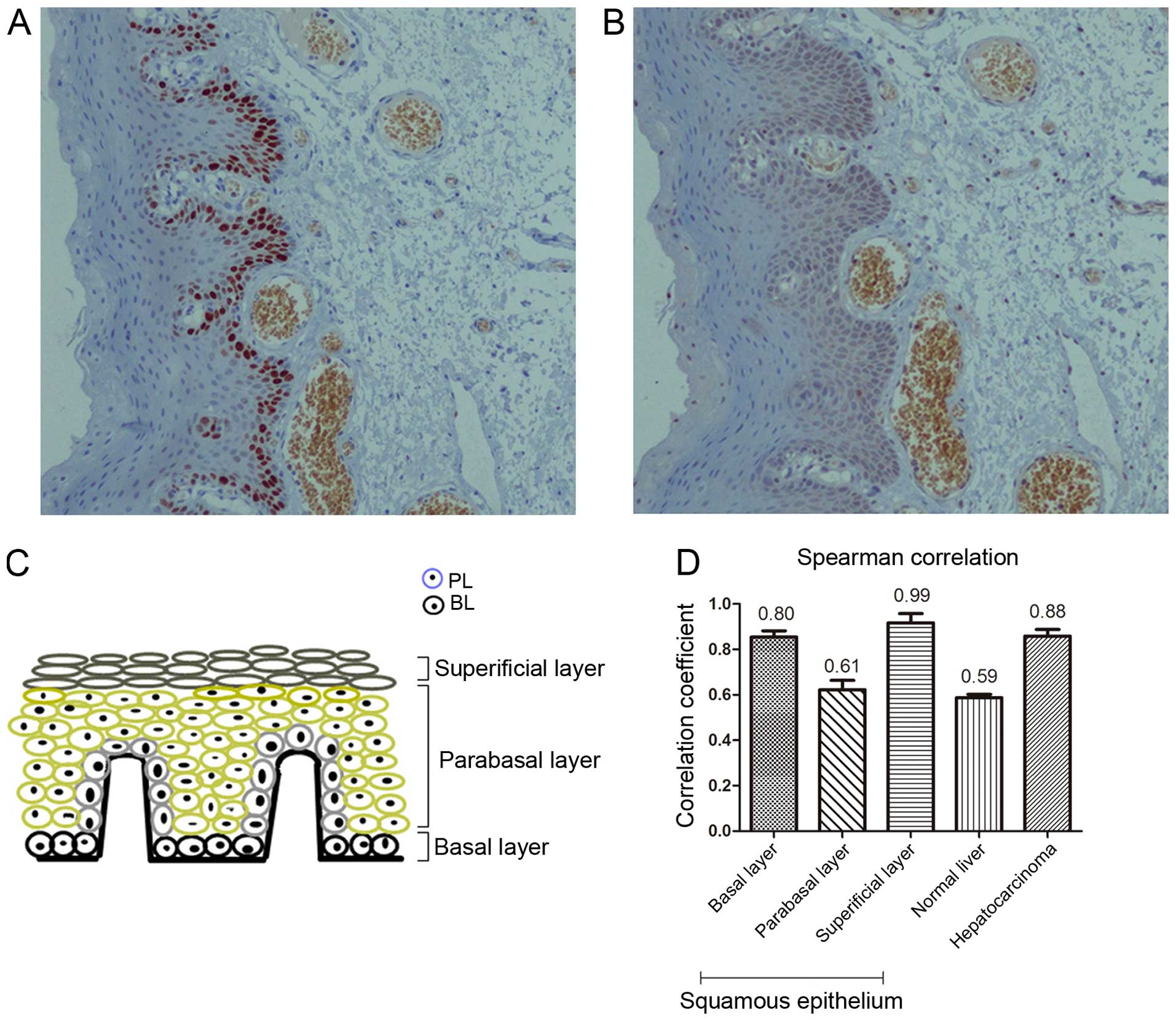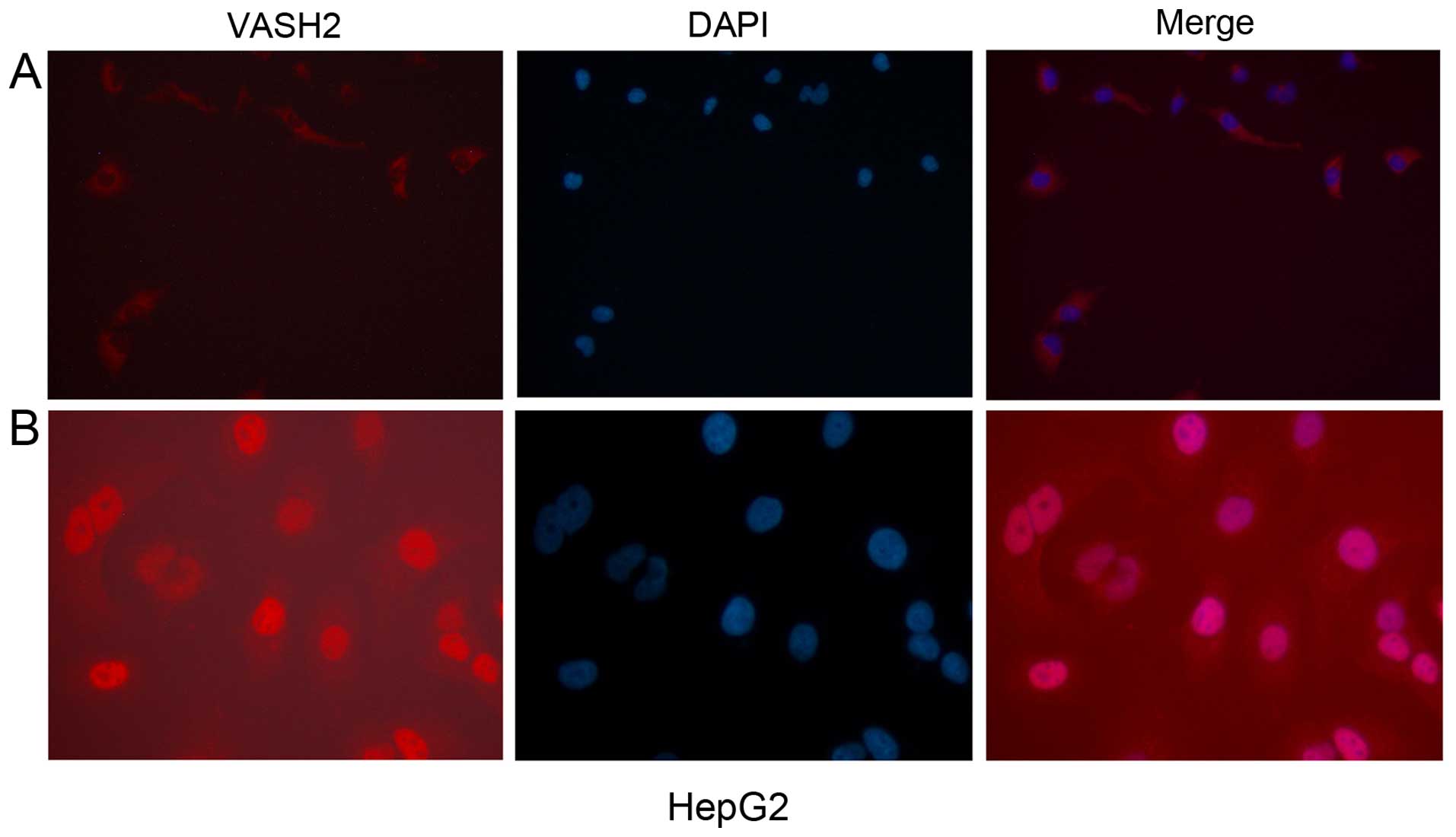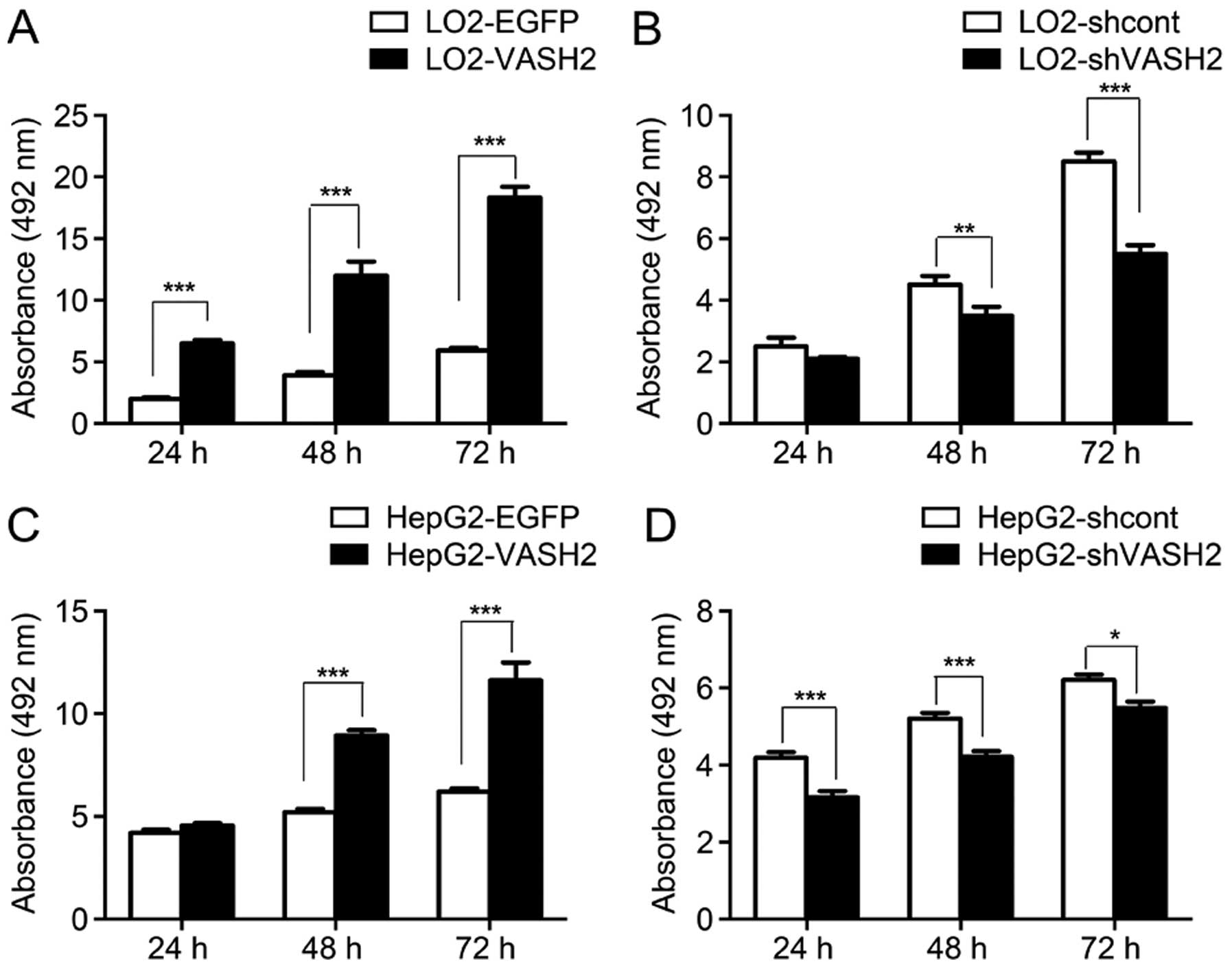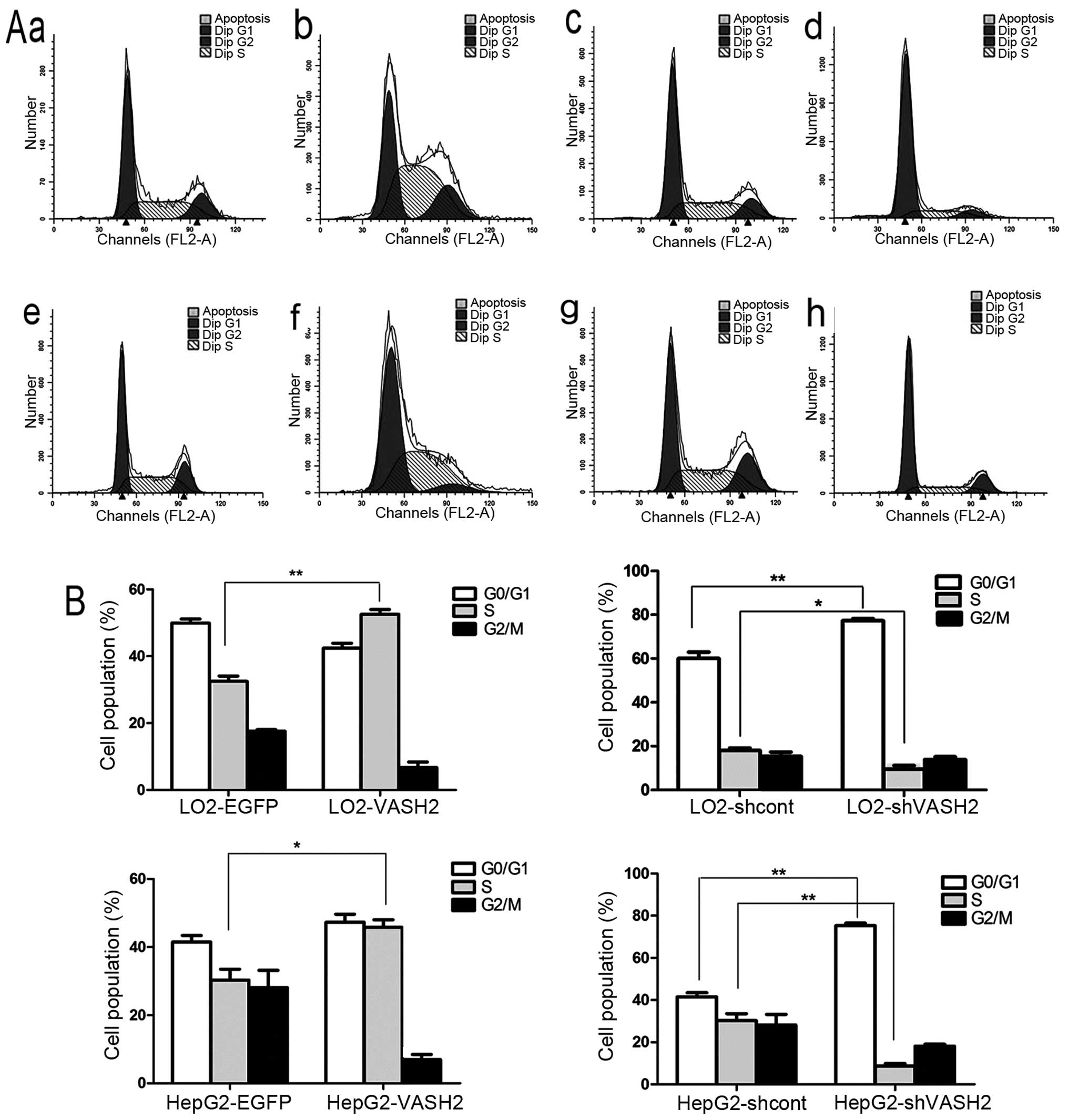Nuclear vasohibin-2 promotes cell proliferation by inducing G0/G1 to S phase progression
- Authors:
- Published online on: July 13, 2015 https://doi.org/10.3892/or.2015.4127
- Pages: 1327-1336
Abstract
Introduction
Vasohibin-2 (VASH2) belongs to the VASH family, which also includes VASH1 (1). VASH2 has been identified as a vascular endothelial growth factor (VEGF)-independent angiogenic factor and is expressed preferentially in mononuclear cells that are mobilized from the bone marrow (1,2). Initial analysis of VASH2 revealed that it is also present in endothelial cells (ECs) in developing human or mouse embryos and that its levels are reduced after birth (3). It was reported that VASH2 is transcriptionally activated in human tumors, promoting angiogenesis and growth in hepatic, ovarian and endometrial carcinoma (4–6). VASH2 has shown a strong and extensive ability to promote tumor by epithelial-mesenchymal transition (EMT), increase the proportion of stem cells and inhibit apoptosis, which beyond paracrine promotes angiogenesis and migration (7,8). VASH2 knockdown in cancer cells prominently inhibits growth and angiogenesis in tumors (9). Furthermore, VASH2 is perceived as a cancer-promoting gene.
However, there are no reliable protein expression studies of VASH2 in human tissue (3). Recently, rabbit anti-human VASH2 polyclonal antibodies were successfully generated for use in western blot analysis (WB) and immunohistochemistry (IHC) (10). It was also determined that, different VASH2 isoforms have different intracellular localizations in HepG2 cells: one (311 amino acids) in the nucleus and the other (355 amino acids) in the cytoplasm (10). According to these differing locations, VASH2 was classified as nuclear and cytoplasmic type (10). Thus, differing locations of VASH2 may have different mechanisms of cell growth promotion. Previous studies have focused on full-length VASH2 (4–9), without a clear distinction between cytoplasmic and nuclear VASH2. In the present study, we focused on nuclear VASH2.
Nuclear VASH2 expression was screened using IHC in human normal and cancer tissues and nuclear VASH2 was found to correlate positively with cell proliferation. The proportion of nuclear VASH2 positivity was positively correlated with the Ki-67-positive proportion in the normal and cancer tissues. Based on these findings, we hypothesized that nuclear VASH2 may be partially involved in the yet unknown mechanisms of cell proliferation. To confirm whether VASH2 is involved in cell proliferation, we stably constructed VASH2 overexpression and knockdown in LO2 and HepG2 cell lines. Cell proliferation was increased in nuclear VASH2-overexpressed cells and decreased in VASH2 knockdown cells. Nuclear VASH2 overexpression promoted G0/G1 to S phase progression, while VASH2 knockdown induced upregulation of the G0/G1 population. As far as we know, this is the first study to show that nuclear VASH2 promotes cell proliferation by inducing G0/G1 to S phase progression. The present study provides a better understanding of the function of VASH2.
Materials and methods
Tissue microarray and IHC
High-density, multiple organ tumors and normal tissue microarray (MC5003a) and multiple organ normal tissue microarrays (FDA999b) were purchased from Biomax (Rockville, MD, USA) for IHC. Squamous epithelial, adjacent non-tumor liver and hepatic cancer tissues were obtained from patients at the First Affiliated Hospital of Nanjing Medical University (Nanjing, China). Written informed consent was obtained from all the patients. The Research Ethics Committee of Nanjing Medical University approved the present study. Primary antibodies used in the present study were as described previously (10): rabbit polyclonal anti-VASH2 (self-prepared) and rabbit polyclonal anti-Ki-67 (Fuzhou Maixin Biotechnology, Fuzhou, China). Ki-67 and nuclear VASH2 staining were evaluated by calculating the proportion of positively stained cells: One thousand cells were counted in each of the 10 randomly selected high-power fields.
Cell culture
The L02 cells were kindly provided by Professor Beicheng Sun of the Department of General Surgery, The First Affiliated Hospital of Nanjing Medical University (Jiangsu, China). Human HepG2 liver cancer cells were obtained from the American Type Culture Collection (ATCC; Manassas, VA, USA). The cells were cultured in Dulbecco's modified Eagle's medium (DMEM) containing 10% fetal bovine serum (FBS) (both from Wisent, QC, Canada) and 100 mg/ml penicillin and 100 mg/ml streptomycin (HyClone, Logan, UT, USA) at 37°C in 5% CO2.
Plasmid construction and lentivirus packaging
The highly expressed VASH2 (355 amino acid residues) plasmid fused with the DDK tag at the c-terminal was constructed as previously described (15). VASH2 cDNA (encoding for 311 amino acid residues) purchased from Origene (Rockville, MD, USA) was fused with V5 tag at the c-terminal and cloned into the Lv-CMV-EGFP vector. The plasmids were verified by sequencing (Invitrogen, Shanghai, China). Lentiviral (Lv) constructs were designed to induce nuclear VASH2 overexpression and knockdown, as previously described (4,10). The primer pair for the VASH2 plasmid (311 amino acid residues) was as follows: forward, 5′-CGGCTAGCCCCACCATGA CCGGCTC-3′ and reverse, 5′-AACTGCAGCTACGTAGAA TCGAGACCGAGGAGAGGGTTAGGGATAGGCTTACCA ATTCGGATTTGATAGCCCACTT-3′ (V5-tag) (10). LO2 and HepG2 cells were stably transfected with Lv-cytomegalovirus (CMV)-VASH2 for VASH2 overexpression (encoding for 311 amino acid residues) and designated as LO2-VASH2 and HepG2-VASH2, respectively. LO2 and HepG2 cells stably transfected with Lv-CMV-EGFP (enhanced green fluorescent protein) as controls were designated as LO2-EGFP and HepG2-EGFP, respectively. LO2 and HepG2 cells stably transfected with VASH2-targeting short hairpin RNA (shRNA) lentivirus for VASH2 knockdown (both 355 and 311 amino acid residues were downregulated) were designated as LO2-shVASH2 and HepG2-shVASH2, respectively. For knockdown, the shv2 construct, with ≥85% knockdown efficiency, was used for subsequent studies (Fig. 4). This shRNA sequences used for subsequent studies were: shVASH2, 5′-CCGGTTTGACT TTGAGGACTCTTACCTCGAGGTAAGAGTCCTCAAAG TAAATTTTTG-3′; shScrambled, 5′-CCGGCCTAAGGT TAAGTCGCCCTCGCTCGAGCGAGGGCGACTTAACCT TAGGTTTTTG-3′ (4). LO2 and HepG2 cells stably transfected with scrambled shRNA lentivirus as controls were designated as LO2-shcont and HepG2-shcont, respectively.
Immunofluorescence
HepG2 cell line was arrayed in a 24-well plate (Corning Inc., NY, USA) and immunofluorescence was performed as previously described (11,12). The polyclonal antibodies were diluted as previously described (10). Mouse-anti-DDK antibody was purchased from Abmart (Arlington, MA, USA). The secondary antibody used was the goat anti-rabbit IgG-dylight 593 (Sigma-Aldrich, St. Louis, MO, USA). The nucleus dye, 10 µg/ml DAPI (Sigma-Aldrich) was diluted in PBS. The cells were then observed under a fluorescence microscope (Olympus, Tokyo, Japan).
Bromodeoxyuridine (BrdU) cell proliferation assay
Cultured cells (1×105/well) were plated in 96-well plates. Cell proliferation at 24, 48 and 72 h was evaluated using a BrdU Cell Proliferation Assay kit (cat. no. 11647229001; Roche Applied Science, Mannheim, Germany) according to the manufacturer's instructions. The cell proliferation rate was determined by measuring the absorbance at 492 nm using a computer-controlled microplate reader (Multiskan FC; Thermo Scientific, Waltham, MA, USA) (13).
Fluorescence-activated cell sorting analysis
Cells were collected, washed with 300 µl cold phosphate-buffered saline and precipitated with 3 ml cold 75% ethanol. Cells to be used for fluorescence-activated cell sorting (FACS) were stored at −20°C in 75% ethanol for 16 h, stained with propidium iodide for 30 min at 37°C and the DNA content analyzed using a FACS Calibur unit (BD Biosciences, Allschwil, Switzerland) (14).
Nuclear extraction analysis and western blot analysis
Cytoplasmic and nuclear protein samples were isolated using a Nuclear Extraction kit 2900 (Millipore, Billerica, MA, USA) according to the manufacturer's instructions. Total cell lysates were prepared using a radioimmunoprecipitation assay buffer (Beyotime, Nantong, China). Protein quantities of 40 µg/lane for LO2 cell synchronization were used for western blotting. Polyvinylidene difluoride membranes (Millipore) were blocked with 5% non-fat dried milk and incubated overnight at 4°C with the appropriate primary antibodies. The rabbit anti-human VASH2 polyclonal antibody was used as reported previously described (10).
Statistical analysis
A two-sample t-test was performed to compare the mean IHC scores for nuclear VASH2 between benign and malignant tissues overall and in a specific organ/system. The Spearman's rank correlation test was used for correlation analysis between nuclear VASH2 and Ki-67. Cell cycle group comparison was performed using an independent sample t-test. We used the Student-Newman-Keuls test for inequality of unpaired multiple data sets to determine significant differences in BrdU absorbance in the 24-, 48- and 72-h groups.
Results
Screening of nuclear VASH2 expression in normal and tumor tissues
We used a tissue microarray chip (547 specimens) to identify expression trends to analyze nuclear VASH2 expression in human normal and tumor tissues. Based on the tissue microarray, there were 34 normal human tissue (140 specimens), 22 primary malignant tumor (383 specimens) and 9 tumor-adjacent normal tissue types (24 specimens). There was positive VASH2 staining in 27.1% (38/140) of the normal human tissues. The 16 VASH2-negative normal mature human tissue types were derived from the ovary, breast, tonsil, thymus gland, lung, cardiac muscle, stomach, liver, prostate, skeletal muscle, peripheral nerves, mesothelium, larynx, soft tissue, colon and bladder (Fig. 1A). VASH2 expression localized to the nucleus was detected in the remaining 18 tissue types, including the cerebrum (3/6), cerebellum (1/3), adrenal gland (2/2), parathyroid gland (2/3), hypophysis (2/3), testis (4/8), pancreas (2/8), spleen (3/3), small intestine (2/3), salivary gland (1/2), kidney (1/3), endometrium (1/3), skin (6/7), brain (2/5), thyroid (2/8), lymph node (2/5), cervix uteri (1/1) and esophagus (2/5) (Fig. 1A).
In the normal tissue specimens, there was usually an absence of cell proliferation in the nuclear VASH2-negative tissues (Fig. 2), whereas there was usually strong cell and nuclear division and cytokinesis in nuclear VASH2-positive tissues (Fig. 2). There was deep nuclear VASH2 staining in the basal and parabasal layer cells of normal skin, small intestine, cervix uteri and esophageal tissues and these tissues were accompanied by numerous mitotic figures (Fig. 2).
We observed positive nuclear VASH2 staining in seven tumor-adjacent normal tissue types, including colon (2/2), salivary gland (1/1), skin (1/1), eye (2/3), larynx (1/1), ovary (1/4) and uterine cervix (6/7) (Fig. 1B). The nuclear VASH2-positive proportion in primary malignant tumor tissue specimens (22 tumor types) (64.8%, 248/383) (Fig. 1) was significantly higher than that of normal tissues (27.1%, 38/140, P<0.001). In addition, the tumor tissues were characterized by high proliferation capability (20). A high VASH2 expression in the nucleus was correlated with strong cytokinesis; dark, pathological mitotic figures; large, deeply stained nuclei and a high nucleo-cytoplasmic ratio (Fig. 2). However, these results need to be reconfirmed with an increasing size in these tissues. Table I showed significant differences in the expression levels of nuclear VASH2 between benign and malignant changes in different tissues. Based on these observations, it was determined that nuclear VASH2 may correlate with cell proliferation.
Table IStatistically significant nuclear VASH2 expression levels (IHC score) between benign and malignant changes in different organs/tissues. |
Positive correlation of nuclear VASH2 with cell proliferation
To examine the relationship between nuclear VASH2 and cell proliferation, we investigated nuclear VASH2 expression in proliferative normal squamous epithelium, adjacent non-tumor liver and hepatocarcinoma tissues. Proliferation was assessed by detecting Ki-67, which is widely used as a proliferation marker in histopathology (15–18). The Ki-67- and nuclear VASH2-positive proportion were highest in the basal layer (75.00±5.00 and 85.00±5.01%, respectively), intermediate in the parabasal layer (25.03±5.05 and 31.33±6.65%, respectively) and lowest in the superficial layer (2.10±1.15 and 4.00±1.00%, respectively) of normal squamous epithelium tissues (n=15, Fig. 3). We also calculated the Ki-67 and nuclear VASH2-positive proportion in the adjacent non-tumor liver tissues (n=15, 27.67±2.51 and 32.67±2.57%, respectively) and hepatocarcinoma tissues (n=15, 78.00±2.00 and 76.00±3.60%, respectively). The nuclear VASH2-positive proportion was positively correlated with the Ki-67-positive proportion in the basal (r=0.80, P<0.05), parabasal (r=0.61, P<0.05), superficial layer (r=0.99, P<0.05), adjacent non-tumor (r=0.59, P<0.05) and malignant liver tissues (r=0.88, P<0.05, Fig. 3). These observations suggested that nuclear VASH2 was positively correlated with cell proliferation.
Generation and identification of stably transfected cells
Previous findings showed that full-length VASH2 promoted growth and angiogenesis in hepatocellular carcinoma (HCC) (4,8). Therefore, to investigate the functions of nuclear VASH2 in cell proliferation, we overexpressed and silenced nuclear VASH2 expression in LO2 and HepG2 cells. We constructed VASH2 overexpression (311 amino acid residues) and VASH2-knockdown lentiviral constructs, infected HepG2 cells and selected stably infected cells for further study. We confirmed expression levels using western blot analysis (Fig. 4). The stable cells of LO2 were treated in the same manner as HepG2.
To verify the localization of nuclear VASH2, immunofluorescence analysis was performed for the HepG2-VASH2 (transient overexpressed c-terminal V5 tag 311 and c-terminal DDK-tagged 355 amino acid residues VASH2). The HepG2-VASH2 (311 amino acid residues) nucleus was stained red while the cytoplasm was red in the HepG2-VASH2 (355 amino acid residues) under the fluorescence microscope (Fig. 5).
Nuclear VASH2 promotes cell proliferation in vitro
We determined the proliferation ability of LO2-EGFP, LO2-VASH2, LO2-shcont, LO2-shVASH2, HepG2-EGFP, HepG2-VASH2, HepG2-shcont and HepG2-shVASH2 cells with BrdU analysis. The BrdU uptake assay revealed an increased DNA synthesis in LO2-VASH2 cells compared to LO2-EGFP cells (24-, 48-, 72-h post-plating; all P<0.001, Fig. 6); decreased DNA synthesis in LO2-shVASH2 cells after 48- and 72-h incubation (P<0.01 and P<0.001, respectively, vs. LO2-shcont cells, Fig. 6); markedly increased proliferation ability of HepG2-VASH2 cells compared to the control cells (24-, 48-, 72-h post-plating; all P<0.001 vs. HepG2-shVASH2 cells, Fig. 6); and decreased DNA synthesis in HepG2-shVASH2 cells after 48- and 72-h incubation (P<0.05 and P<0.001, respectively, vs. HepG2-shcont cells, Fig. 6). Compared to the control group, nuclear VASH2 overexpression in the LO2 and HepG2 cells resulted in significantly increased cell proliferation. VASH2 knockdown significantly reduced the proliferation of HepG2-shVASH2 compared to the HepG2-shcont and LO2 cells. These results indicated that nuclear VASH2 promotes cell proliferation. Considering BrdU incorporation can also be used to determine the S phase of the cell cycle (19), we hypothesized that nuclear VASH2 promotes cell proliferation by inducing cell cycle progression to the S phase.
Nuclear VASH2 induces cell cycle progression from G0/G1 to S phase
Compared with the control LO2-EGFP cells, there was an increased relative proportion of LO2-VASH2 cells in the S phase (30.44±4.26 vs. 52.56±5.32%, P<0.01, Fig. 7). Compared with the control LO2-shcont cells, there was an increased relative proportion of LO2-shVASH2 cells in the G0/G1 phase (60.05±3.38 vs. 75.88±12.22%, P<0.05, Fig. 7), but a reduced relative proportion of LO2-shVASH2 cells in the S phase (30.91±5.32 vs. 10.51±6.01%, P<0.01, Fig. 7). Compared with the control HepG2-EGFP cells, there was an increased relative proportion of HepG2-VASH2 cells in the S phase (30.05±10.92 vs. 45.13±5.22%, P<0.05, Fig. 7). Compared with the control HepG2-shcont cells, there was an increased relative proportion of HepG2-shVASH2 cells in the G0/G1 phase (41.53±16.86 vs. 73.87±7.35%, P<0.01, Fig. 7), but a reduced relative proportion of HepG2-shVASH2 cells in the S phase (35.47±10.36 vs. 9.87±3.12%, P<0.01, Fig. 7). These results suggested that nuclear VASH2 induced cell cycle progression from G0/G1 to the S phase.
Discussion
Previously, it was reported that VASH2 is an angiogenesis factor associated with carcinoma angiogenesis and malignant transformation (1–6). VASH2 knockdown in cancer cells inhibits tumor growth and angiogenesis in an obvious manner (9). Besides that VASH2 also has shown a strong and extensive ability to promote tumor to EMT, increase the proportion of stem cells and inhibit apoptosis (7,8). We generated VASH2 polyclonal antibodies for immunoblotting and IHC (10). Based on its intracellular locations, we classified VASH2 into nuclear (with 311 amino acid residues) and cytoplasmic types (with 355 amino acid residues) (10). In the present study, we focused on nuclear VASH2, which, has not yet to be investigated so far.
We analyzed nuclear VASH2 levels in 547 tissue specimens, finding that proliferative cells in normal tissues tended to be nuclear VASH2-positive. Nuclear VASH2 was also expressed in most of the primary malignant tumor specimens, which are always highly proliferative (20). These observations indicated that nuclear VASH2 may be associated with cell proliferation.
Ki-67 is a good marker for detecting cell proliferation (18). We found that nuclear VASH2 staining was consistent with Ki-67 staining in normal squamous epithelial, adjacent non-tumor liver and hepatic cancer tissue. There was a high nuclear VASH2 expression in the basal and parabasal layers of the normal squamous epithelial tissue, where cell proliferation is high, whereas nuclear VASH2 was rarely expressed in the superior basal layer, where there is no mitosis or proliferation. In the adjacent non-tumor liver tissues, Ki-67 staining was consistent with that of nuclear VASH2. In malignant hepatic tissues with a strong self-renewal ability, high Ki-67 staining was accompanied by a similarly high nuclear VASH2 staining. There was a significant positive correlation between nuclear VASH2 and Ki-67 staining, which indicates that nuclear VASH2 correlates positively with cell proliferation.
To identify the correlation between nuclear VASH2 and cell proliferation, we established nuclear VASH2 overexpression and knockdown cell models and used them in the BrdU proliferation test. Nuclear VASH2 overexpression in LO2 and HepG2 cells increased BrdU absorbance, while VASH2 knockdown decreased it, with only mitotic S-phase cells incorporating BrdU (21–22). Nuclear VASH2 increased the S-phase population and promoted cell proliferation. Based on these findings, we determine that nuclear VASH2 may promote cell progression by regulating the cell cycle.
To confirm this hypothesis, we analyzed the effect of nuclear VASH2 overexpression and knockdown on the cell cycle. Cell cycle analysis showed that VASH2 knockdown in LO2 and HepG2 cells increased the G0/G1 population and decreased the S-phase population and nuclear VASH2 overexpression promoted G0/G1 progression to the S phase. These results indicate that nuclear VASH2 regulates cell cycle progression from G0/G1 to the S phase.
An in vivo tumorigenicity experiment using HepG2 cells reported that VASH2 knockdown inhibited tumor growth significantly, while cytoplasmic VASH2 overexpression did not lead to greater tumor growth compared to the control cells (4). Using in vitro tetrazolium bromide proliferation assays, Xue et al (4) reported a significantly decreased proliferation rate of HepG2-shVASH2 (VASH2 knockdown) compared to HepG2 cells, while there were no differences between cytoplasmic VASH2-overexpressing HepG2-VASH2 (with 355 amino acid residues) and HepG2 cells. Cytoplasmic VASH2 did not promote cell proliferation in HepG2 cells in vitro and in vivo. The authors attributed this to the possibility that VASH2 expression in HepG2 cells is already relatively high and that the exogenous VASH2 overexpression did not alter its function (4). Both nuclear and cytoplasmic VASH2 were silenced when VASH2 was knocked down by shRNA, but the VASH2 overexpression detected was only that of cytoplasmic VASH2 in the study by Xue et al (4). In the present study, we confirmed that nuclear VASH2, encoding 311 amino acids, plays a definite role in promoting cell proliferation, where its overexpression (with 311 amino acid residues) induced cell proliferation significantly in HepG2 cells. Previously, we also determined that nuclear VASH2 is dominant while cytoplasmic VASH2 expression is very low in HepG2 cells (10). Our results are not in concordance with the those of Xue et al (4) who reported that VASH2 expression in HepG2 cells is already relatively high and that exogenous VASH2 overexpression has no effect on cell proliferation. We attribute the effect on HepG2 cell proliferation to nuclear VASH2, not cytoplasmic VASH2. However, we concede that cytoplasmic VASH2 may not promote cell proliferation in HepG2 cells.
Thus, to the best of our knowledge, the present study is the first to identify that nuclear VASH2 promotes cell proliferation. The present study improves the understanding of the functions of VASH2. However, the precise mechanism by which nuclear VASH2 regulates cell proliferation remains to be investigated.
Acknowledgments
The present study was partially supported by the National Natural Science Foundation of China (nos. 81272239, 81170336, 81172267 and 81372657), the Program for Development of Innovative Research Team in the First Affiliated Hospital of the Nanjing Medical University (Jiangsu, China), the Priority Academic Development Program of Jiangsu Higher Education Institutions (PAPD, JX10231801), the Special Research Fund for Public Welfare Industry of Health (201202007) and the Graduate Education Innovation Project of Jiangsu Province (JX22013230).
References
|
Shibuya T, Watanabe K, Yamashita H, Shimizu K, Miyashita H, Abe M, Moriya T, Ohta H, Sonoda H, Shimosegawa T, et al: Isolation and characterization of vasohibin-2 as a homologue of VEGF-inducible endothelium-derived angiogenesis inhibitor vasohibin. Arterioscler Thromb Vasc Biol. 26:1051–1057. 2006. View Article : Google Scholar : PubMed/NCBI | |
|
Suzuki Y, Kobayashi M, Miyashita H, Ohta H, Sonoda H and Sato Y: Isolation of a small vasohibin-binding protein (SVBP) and its role in vasohibin secretion. J Cell Sci. 123:3094–3101. 2010. View Article : Google Scholar : PubMed/NCBI | |
|
Sato Y: The vasohibin family: A novel family for angiogenesis regulation. J Biochem. 153:5–11. 2013. View Article : Google Scholar | |
|
Xue X, Gao W, Sun B, Xu Y, Han B, Wang F, Zhang Y, Sun J, Wei J, Lu Z, et al: Vasohibin 2 is transcriptionally activated and promotes angiogenesis in hepatocellular carcinoma. Oncogene. 32:1724–1734. 2013. View Article : Google Scholar | |
|
Takahashi Y, Koyanagi T, Suzuki Y, Saga Y, Kanomata N, Moriya T, Suzuki M and Sato Y: Vasohibin-2 expressed in human serous ovarian adenocarcinoma accelerates tumor growth by promoting angiogenesis. Mol Cancer Res. 10:1135–1146. 2012. View Article : Google Scholar : PubMed/NCBI | |
|
Koyanagi T, Saga Y, Takahashi Y, Suzuki Y, Suzuki M and Sato Y: Downregulation of vasohibin-2, a novel angiogenesis regulator, suppresses tumor growth by inhibiting angiogenesis in endometrial cancer cells. Oncol Lett. 5:1058–1062. 2013.PubMed/NCBI | |
|
Tu M, Liu X, Han B, Ge Q, Li Z, Lu Z, Wei J, Song G, Cai B, Lv N, et al: Vasohibin-2 promotes proliferation in human breast cancer cells via upregulation of fibroblast growth factor-2 and growth/differentiation factor-15 expression. Mol Med Rep. 10:663–669. 2014.PubMed/NCBI | |
|
Li Z, Tu M, Han B, Gu Y, Xue X, Sun J, Ge Q, Miao Y, Qian Z and Gao W: Vasohibin 2 decreases the cisplatin sensitivity of hepatocarcinoma cell line by downregulating p53. PLoS One. 9:e903582014. View Article : Google Scholar : PubMed/NCBI | |
|
Koyanagi T, Suzuki Y, Saga Y, Machida S, Takei Y, Fujiwara H, Suzuki M and Sato Y: In vivo delivery of siRNA targeting vasohibin-2 decreases tumor angiogenesis and suppresses tumor growth in ovarian cancer. Cancer Sci. 104:1705–1710. 2013. View Article : Google Scholar : PubMed/NCBI | |
|
Sun J, Tu M, Han B, Xue X, Zhang Y, Wei J, Chen J, Lu Z, An Y, Cai B, et al: Generation and characterization of rabbit polyclonal antibodies against Vasohibin-2 for determination of its intracellular localization. Int J Oncol. 43:255–261. 2013.PubMed/NCBI | |
|
Tang S, Wang Y, Zhang D, Gao Y, Ma Y, Yin B, Sun J, Liu J and Zhang Y: Reprogramming donor cells with oocyte extracts improves in vitro development of nuclear transfer embryos. Anim Reprod Sci. 115:1–9. 2009. View Article : Google Scholar | |
|
Lin J, Lin X, Yang GH, Wang Y, Peng BW and Lin JY: Toxoplasma gondii: Expression of GRA1 gene in endoplasmic reticulum promotes both growth and adherence and modulates intracellular calcium release in macrophages. Exp Parasitol. 125:165–171. 2010. View Article : Google Scholar : PubMed/NCBI | |
|
Dolbeare F: Bromodeoxyuridine: A diagnostic tool in biology and medicine, part III. proliferation in normal, injured and diseased tissue, growth factors, differentiation, DNA replication sites and in situ hybridization. Histochem J. 28:531–575. 1996. View Article : Google Scholar : PubMed/NCBI | |
|
Danova M, Riccardi A and Mazzini G: Cell cycle-related proteins and flow cytometry. Haematologica. 75:252–264. 1990.PubMed/NCBI | |
|
Scholzen T and Gerdes J: The Ki-67 protein: From the known and the unknown. J Cell Physiol. 182:311–322. 2000. View Article : Google Scholar : PubMed/NCBI | |
|
Cohen SM, Ohnishi T, Clark NM, He J and Arnold LL: Investigations of rodent urinary bladder carcinogens: Collection, processing, and evaluation of urine and bladders. Toxicol Pathol. 35:337–347. 2007. View Article : Google Scholar : PubMed/NCBI | |
|
Dwivedi N, Chandra S, Kashyap B, Raj V and Agarwal A: Suprabasal expression of Ki-67 as a marker for the severity of oral epithelial dysplasia and oral squamous cell carcinoma. Contemp Clin Dent. 4:7–12. 2013. View Article : Google Scholar : PubMed/NCBI | |
|
Kramer E, Herman O, Frand J, Leibou L, Schreiber L and Vaknine H: Ki67 as a biologic marker of basal cell carcinoma: A retrospective study. Isr Med Assoc J. 16:229–232. 2014.PubMed/NCBI | |
|
Luo Y, Kleiboeker S, Deng X and Qiu J: Human parvovirus B19 infection causes cell cycle arrest of human erythroid progenitors at late S phase that favors viral DNA replication. J Virol. 87:12766–12775. 2013. View Article : Google Scholar : PubMed/NCBI | |
|
Robertson DS: The development of tumor cell characteristics. J Cell Physiol. 229:705–710. 2014. View Article : Google Scholar : PubMed/NCBI | |
|
Zhao P, Fu JL, Yao BY, Jia YR and Zhou ZC: S phase cell percentage normalized BrdU incorporation rate, a new parameter for determining S arrest. Biomed Environ Sci. 27:215–219. 2014.PubMed/NCBI | |
|
Bahrami F, Morris DL, Rufener L and Pourgholami MH: Anticancer properties of novel aminoacetonitrile derivative monepantel (ADD 1566) in pre-clinical models of human ovarian cancer. Am J Cancer Res. 4:545–557. 2014.PubMed/NCBI |



